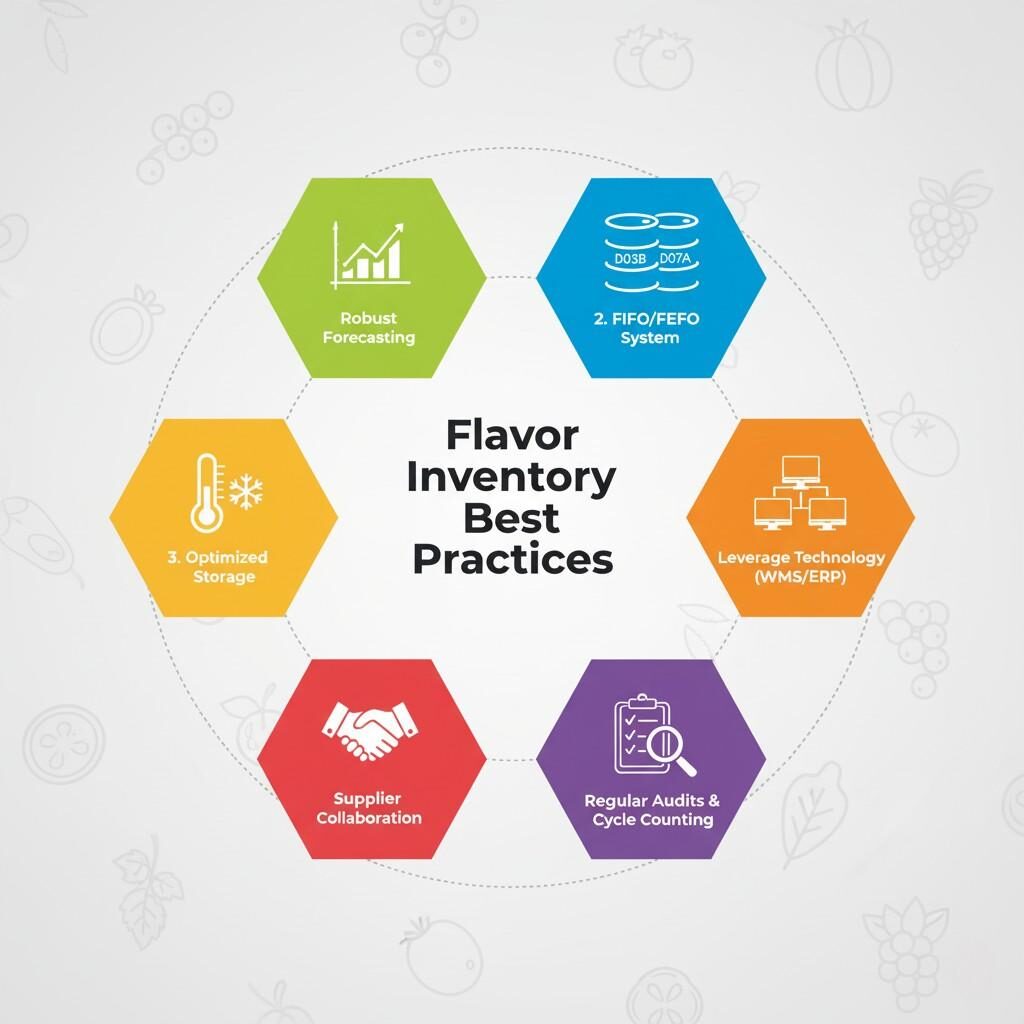Author: R&D Team, CUIGUAI Flavoring
Published by: Guangdong Unique Flavor Co., Ltd.
Last Updated: Oct 28, 2025

Flavor Warehouse Operations
In the dynamic and highly competitive world of food and beverage manufacturing, flavors are not just ingredients; they are the heart and soul of a product, defining its identity and captivating consumers. From a nuanced vanilla extract in a gourmet dessert to a bold, zesty citrus in a refreshing beverage, flavors dictate consumer preference and drive market success. Yet, the critical role of flavors often belies the complexities of managing their inventory. This isn’t merely about counting bottles and barrels; it’s about safeguarding quality, optimizing operational efficiency, mitigating waste, and ultimately, protecting profitability. For food manufacturers, effective flavor inventory management is an indispensable component of a successful supply chain strategy, demanding precision, foresight, and a deep understanding of both market trends and technical specifications.
This comprehensive guide delves into the intricacies of flavor inventory management, offering best practices tailored specifically for food manufacturers. We will explore the unique challenges flavors present—their diverse forms, varying shelf lives, specific storage requirements, and the financial implications of obsolescence or stockouts. Our aim is to provide actionable insights and strategic approaches that will empower manufacturers to not only streamline their inventory processes but also enhance product quality, reduce costs, and maintain a competitive edge. By mastering the art and science of flavor inventory, food manufacturers can ensure their products consistently deliver the taste experiences consumers crave, while simultaneously optimizing their bottom line.
Unlike generic raw materials, flavors present a distinct set of challenges that demand specialized inventory management strategies. Understanding these nuances is the first step toward building a robust and efficient system.
The food and beverage industry is notoriously susceptible to shifting consumer preferences and seasonal trends. A flavor that is a bestseller one quarter might see reduced demand the next. Product launches, marketing campaigns, and even global events can dramatically impact the required quantities of specific flavors. This volatility makes accurate forecasting a continuous challenge. Holding too much of a declining flavor ties up capital and risks spoilage, while holding too little can lead to production delays and lost sales opportunities for popular products.
Flavors come in an astonishing array of forms: liquid extracts, emulsions, powders, pastes, and encapsulated varieties. Each form may require different storage conditions, handling procedures, and tracking methodologies. Liquid flavors might be stored in drums, IBCs, or smaller bottles, while powders might be in bags or cartons. This diversity necessitates flexible inventory systems capable of accommodating various unit measures and physical characteristics.
Perhaps the most critical challenge is the finite shelf life of flavors. Unlike non-perishable goods, flavors degrade over time, losing potency, altering taste profiles, or even becoming microbiologically unstable. The “best before” or “use by” dates are not merely suggestions; they are critical markers for quality and safety. Managing multiple flavors with varying shelf lives—some as short as a few months, others extending to a year or more—requires a meticulous first-in, first-out (FIFO) or first-expired, first-out (FEFO) system to minimize waste and ensure consistent product quality.
Flavors are often sensitive to environmental conditions. Many require specific temperatures (e.g., refrigeration for certain natural extracts), protection from light, humidity control, and isolation from cross-contaminants. Improper storage can accelerate degradation, leading to off-notes, reduced intensity, or outright spoilage. Maintaining these precise conditions adds a layer of complexity to warehouse design and management.
Food flavors are subject to stringent regulatory oversight from bodies like the FDA in the United States, EFSA in Europe, and similar agencies globally. This necessitates meticulous record-keeping to ensure traceability from the supplier to the finished product. In the event of a recall or quality issue, manufacturers must be able to quickly identify batches of flavor used, their origin, and their destination. Maintaining this level of detail for every flavor ingredient is a non-negotiable aspect of inventory management. According to the U.S. Food and Drug Administration (FDA), “traceability allows for the tracking of food products through the supply chain, facilitating the quick removal of contaminated products from the market and protecting public health.” (FDA, Food Traceability Final Rule, 2022).
Flavors, especially highly specialized or natural extracts, can be significant cost drivers. Spoilage due to improper inventory management directly impacts profitability. Overstocking ties up working capital and incurs holding costs (storage, insurance, obsolescence), while understocking can lead to emergency orders (often at higher prices), production downtime, and lost sales. Balancing these financial considerations is central to effective inventory control.
Addressing these unique challenges requires a strategic, integrated approach, moving beyond basic stock-taking to a comprehensive system that leverages technology, robust processes, and skilled personnel.
Optimizing flavor inventory management demands a multi-faceted approach, integrating strategic planning with meticulous execution. Here are the best practices that can transform a reactive system into a proactive, efficient, and cost-effective operation.
Accurate forecasting is the bedrock of effective inventory management. For flavors, this is particularly challenging due to market volatility.
Given the perishable nature of flavors, a rigorous First-In, First-Out (FIFO) or First-Expired, First-Out (FEFO) system is paramount.
Maintaining the integrity of flavors requires strict adherence to their specific storage requirements.
Modern inventory management is virtually impossible without robust technological support.

Flavor Inventory Best Practices Infographic
Balancing the risk of stockouts against the cost of holding excess inventory is crucial.
Your flavor suppliers are critical partners in your inventory strategy.
Maintaining accurate inventory records is fundamental.
Even the most sophisticated systems are ineffective without well-trained personnel.
Minimizing flavor waste directly impacts profitability and sustainability.
Leverage the data generated by your inventory system to drive continuous improvement.
By integrating these best practices, food manufacturers can transform their flavor inventory management from a challenging burden into a strategic asset, ensuring product quality, operational efficiency, and sustained profitability.

Flavor Supply Chain Tech Integration
As the food and beverage industry continues to evolve, so too must inventory management practices. Embracing advanced strategies and anticipating future trends can provide a significant competitive advantage.
While JIT principles—receiving materials only as they are needed—are often associated with manufacturing efficiency, their application to flavors requires careful consideration due to lead times, minimum order quantities, and shelf life.
VMI shifts the responsibility of managing inventory levels for certain flavors from the manufacturer to the flavor supplier.
The future of inventory management is increasingly digital and automated, especially for complex ingredients like flavors.
As consumers increasingly demand sustainable products, inventory practices must align with these values.
The trend towards customized food and beverage products means that manufacturers may need to manage a wider array of specialty or niche flavors.
Food safety and labeling regulations are constantly evolving. Inventory systems must be adaptable to new requirements.
By proactively embracing these advanced strategies and staying attuned to future trends, food manufacturers can not only optimize their flavor inventory management but also position themselves as innovators and leaders in the ever-changing food landscape. This forward-thinking approach transforms inventory from a mere operational necessity into a powerful strategic advantage.
In the intricate tapestry of food and beverage manufacturing, flavors are more than just ingredients; they are the brushstrokes that define a product’s appeal, the notes that compose its sensory symphony. The journey from a raw flavor compound to a beloved consumer product is paved with countless operational decisions, and among the most critical is the meticulous management of flavor inventory. As we have explored throughout this guide, this isn’t a passive task but an active, strategic endeavor that demands foresight, precision, and an unwavering commitment to quality.
Effective flavor inventory management is the silent guardian of profitability, ensuring that capital is optimized, waste is minimized, and production lines hum with efficiency. It is the steadfast protector of product integrity, guaranteeing that every batch of your product delivers the consistent, captivating taste experience your consumers expect and cherish. Moreover, in an era of heightened regulatory scrutiny and increasing consumer demand for transparency, robust inventory practices are the cornerstone of compliance and trust.
By embracing the best practices outlined here—from sophisticated forecasting and rigorous FIFO/FEFO systems to leveraging advanced technologies like WMS, ERP, and IoT sensors—food manufacturers can transform potential challenges into significant competitive advantages. Developing strong supplier partnerships, fostering a culture of continuous improvement, and empowering a well-trained workforce are equally vital components of this holistic approach.
Looking ahead, the integration of cutting-edge technologies such as AI-driven predictive analytics, blockchain for enhanced traceability, and automated warehousing solutions will redefine the landscape of flavor inventory management. These innovations promise even greater efficiency, accuracy, and resilience, allowing manufacturers to navigate market volatility with enhanced agility. Furthermore, aligning inventory strategies with broader sustainability goals and adapting to evolving consumer trends like customization and clean labels will be paramount for long-term success.
Ultimately, mastering flavor inventory management is about more than just numbers on a spreadsheet; it’s about safeguarding the essence of your brand. It’s about ensuring that the very flavors that differentiate your products are always available, always fresh, and always of the highest quality. By investing in smart, strategic inventory practices, food manufacturers are not just optimizing their operations; they are actively crafting the future of taste, delighting palates, and securing their place in the hearts and minds of consumers worldwide. Let’s work together to make every flavor count.

Smart Production Floor Scanning
Unlock the Full Potential of Your Flavors!
Are you ready to elevate your flavor inventory management and ensure your products consistently deliver exceptional taste? Our team of flavor experts is eager to collaborate with you.
Technical Exchange: Have specific challenges or innovative ideas? Connect with our R&D and supply chain specialists for a personalized technical discussion on optimizing your flavor management strategies. We’re here to share insights and find tailored solutions.
Free Sample Request: Experience the quality and consistency of our flavors firsthand. Request a free sample today and discover how our premium ingredients can enhance your product line while simplifying your inventory planning.
[Contact Us Today for a Technical Exchange / Request Your Free Flavor Samples!]
📩 [info@cuiguai.com]
📞 [+86 189 2926 7983]
🌐 Explore more at【www.cuiguai.cn】
Copyright © 2025 Guangdong Unique Flavor Co., Ltd. All Rights Reserved.